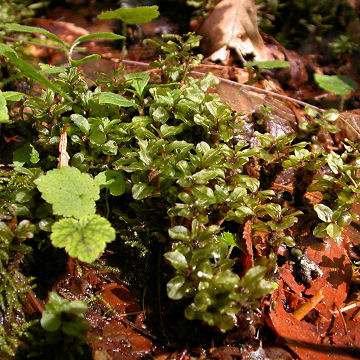

Mnium punctatum - (image 1 of 3)
Taxonomy
Family: Mniaceae
Habitat
On wet soil, humus, decaying logs, or rocks in swampy woods.
Associates
Thuja occidentalis
Distribution
Circumpolar. Greenland to AK, south to GA, AR, CO, and CA.
Morphology
Dioicous moss. Leaves broad with a narrow base, entire, distinctly bordered by linear cells; upper cells not elongate or in oblique rows. Setae single, to 3.5 cm long, reddish; capsules yellowish to brownish, pendulous, short-necked. Male inflorescence a dark cluster of antheridia surrounded by petal-like leaves, forming a splash-cup.
Notes
The specimens shown here are probably var. elatum Schimp, which has large leaves lacking an apiculus and with the costa ending before the apex. This variety is sometimes given specific rank as Rhizomnium magnifolium (Horik.) T. Kop., while var. punctatum would be called Rhizomnium punctatum (Hedw.) T. Kop. The latter has a short, stout apiculus. Mosses in the genus Rhizomnium have entire leaves with a thick, cartilaginous border.
Some mosses, including this one, have cells analogous to those of vascular plants: water conducting tissues called hydroids (similar to xylem) and food conducting cells called leptoids (similar to phloem).
References
Crum, H. 2004. Mosses of the Great Lakes Forest, 4th ed.
The University of Michigan Herbarium. Ann Arbor, MI
USDA, NRCS. 2002. The PLANTS Database, Version 3.5 (http://plants.usda.gov).
National Plant Data Center, Baton Rouge, LA 70874-4490 USA.
|
Michael Hough © 2009 |